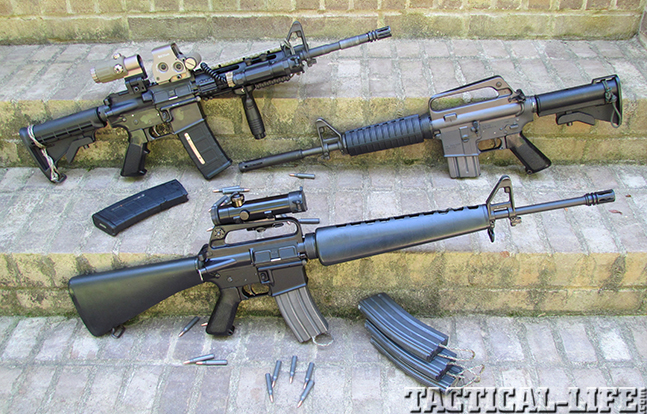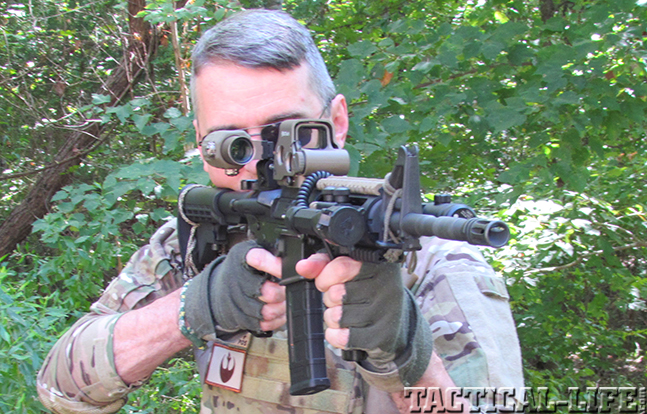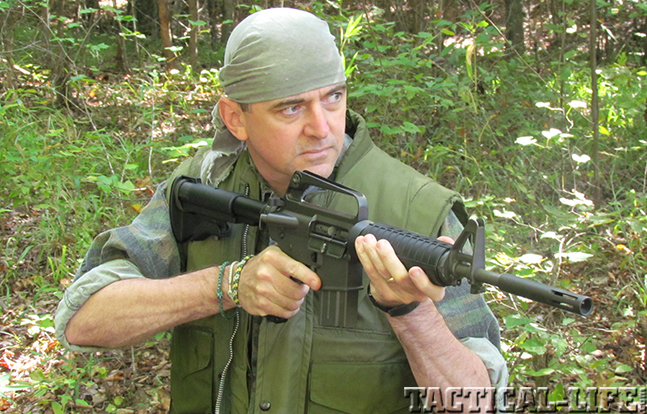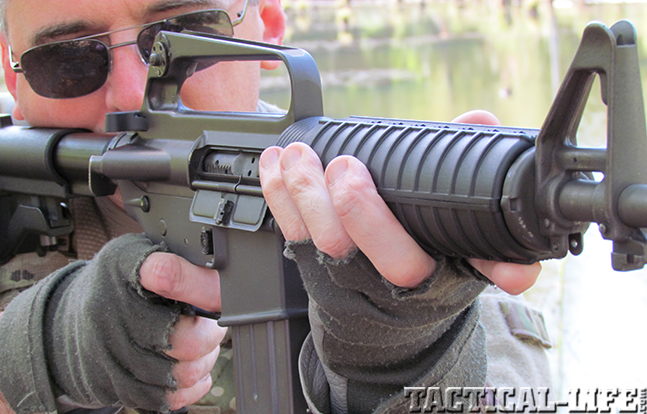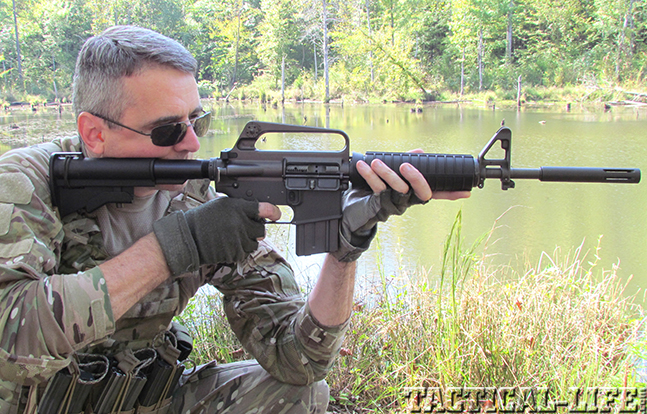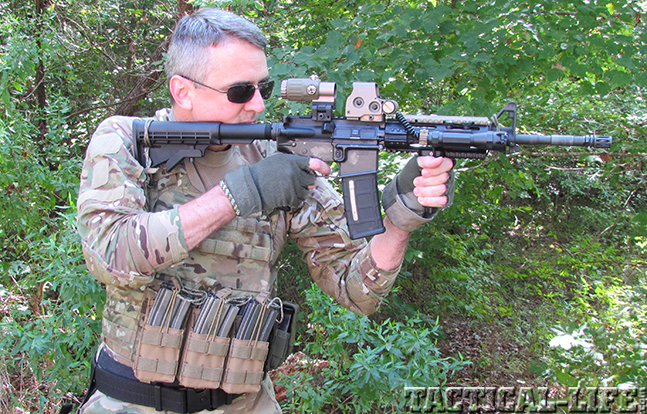The 5.56mm M16 rifle was the object of enormous debate in the first few years after its introduction. Rumors and flat-out falsehoods abounded, both in the popular media, as well as the gun press. Politicians got involved and, in some cases, American soldiers died.
Reports of the efficacy of the then-revolutionary high-velocity .22 caliber round ranged from hopelessly inadequate to unimaginably devastating. In the intervening 50 years or so, the round and the weapons that fire it have been revolutionarily reimagined.
Eugene Stoner was, by all objective, accounts a visionary. As a speculative venture while working for the Fairchild Engine and Aircraft Corporation in California in the mid-1950s, he designed the earliest iteration of what would eventually become the M16.
Advertisement — Continue Reading Below
Applying aluminum casting technology and advanced polymer science perfected for the aircraft industry in World War II, Stoner designed an elegant, lightweight rifle that rethought what it meant to be a military weapon. Where everybody else in the world used Parkerized steel and walnut, Stoner used aluminum and plastic.
The first M16 hit the streets in the early 1960s, and military adoption began with the U.S. Air Force as a result of General Curtis LeMay’s infatuation with the weapon. Interestingly, the first combat use of the rifle by American forces was in our brief, all-but-forgotten military intervention in the Dominican Republic.
When it appeared that the guerillas of the Viet Cong, with their Russian and Chinese AK-47s, might have a firepower advantage over corn-fed Americans carrying M14s, it was determined that something must be done. That something was the expedited adoption of the M16 for use in the jungles of Vietnam.
Advertisement — Continue Reading Below
Adaptive Warriors
Dozens of volumes have been penned on the M16 and its early travails in the humid wastes of Vietnam. As a result of these profound teething troubles, bores and chambers were chrome-plated and U.S. grunts became acquainted with proper cleaning rituals. The resulting M16A1, circa 1970, was a superb weapon for its time when properly maintained.
Advertisement — Continue Reading Below
In an effort to provide a carbine version of the standard M16A1 infantry rifle for use by platoon leaders, dog handlers, aviators and the like, Colt developed what became the XM177E2. This weapon was widely known in Vietnam as the CAR-15. Sporting a 10.5-inch barrel with a sound moderator and a collapsible stock, the CAR-15 represents an intermediate evolutionary step in the advancement of the M16 family.
A major upgrade program in the 1980s added a pound to the M16 platform and warranted a change of designation as well. The M16A2 incorporated an improved sighting system wherein mechanical adjustments could be undertaken on the rear sight alone without any dedicated tools. The barrel had a heavier profile and the handguards were made stronger and interchangeable. Interestingly, only the portion of the barrel ahead of the front sight base was beefed up. The rest of the barrel remained fairly thin to facilitate mounting existing M203 under-barrel grenade launchers.
The earliest M4 variants went into operation in the early 1990s. Employing the collapsible stock and round handguards of the CAR-15, the M4 used an intermediate-length 14.5-inch barrel with the characteristic milled step to facilitate mounting of the slide-action M203 grenade launcher. This mid-length barrel served as a compromise. Longer 20-inch tubes were accurate and reliable but a bit clumsy for use in the CQB arena. Stubby 10.5- and 11.5-inch barrels looked sexy but yielded marginal reliability and atrocious muzzle flash.
Advertisement — Continue Reading Below
Reed Knight’s inspired railed forend changed everything. Now the humble infantry rifle was festooned with tactical lights, lasers of various flavors, foregrips and electronic sighting solutions that ran the spectrum from simple to extraordinary. Man-portable small arms would never be the same.
Generational Shootout
Advertisement — Continue Reading Below
For comparison purposes, I used a semi-auto clone of an M16A1 equipped with a stubby 3x scope that would have been state-of-the-art in 1970. This particular rifle is built up from an original, de-milled Colt parts kit with a new mil-spec, chrome-lined barrel and lower receiver from McKay Enterprises. In this configuration, the rifle is an appropriate representation of the M16A1 in its prime.
The CAR-15 clone is a facsimile of the original XM177E2 adapted slightly to conform to contemporary firearms laws. The barrel is 11.5 inches long and sports a permanently attached, 5.5-inch flash suppressor to meet legal minimums, but it is otherwise a semi-auto ringer for the Vietnam-era carbine.
Advertisement — Continue Reading Below
The M4 is a fair representation of the contemporary service rifle. Built on a select-fire lower receiver, the barrel is a mil-spec, 14.5-inch tube, and the EOTech holographic sight and associated magnifier are both current military issue.
Range Test
Advertisement — Continue Reading Below
The most striking difference in comparing these three rifles is weight. As with everything American, the M16 has put on a few pounds since its introduction back in the 1960s. While the M16A1 and CAR-15 are both remarkably lightweight and maneuverable platforms, the contemporary M4, when fully loaded with electronic bling and a sound suppressor, is much closer to an M1 Garand or Thompson submachine gun in the weight category.
The visceral effect of firing a full-stocked M16A1 with all that spring and buffer reciprocating right next to your face is striking. With each round fired there is a loud twanging that can be both felt and heard through the stock of the rifle. The slick handguards are slippery, particularly when wet with rain or sweat, and the complete rifle is a non-negotiable 38.75 inches long. The 3x Colt scope incorporates a bullet-drop compensator and makes engagements out to 350 to 400 meters fairly easy.
Advertisement — Continue Reading Below
The CAR-15 seems practically weightless by comparison. The iron sights are a bit cluttered compared to contemporary electronic versions, but there are no batteries to fail. The stock is not as comfortable as the full-length solid version from the A1 progenitor, but it does fold up into a fairly tiny package for storage. Given its light weight and abbreviated envelope, the CAR-15 is imminently maneuverable in enclosed spaces.
The modern-day, tricked-out M4 is fairly bulky and heavy. However, where it really comes into its own is indoors and after sundown. The EOTech holographic sight is a magnificent piece of kit, and the rotating magnifier allows optimization for both up-close and distant engagements in moments. An onboard weapon light expands the utility of the rifle exponentially in a CQB environment, and a laser designator allows surgical engagement of targets at modest ranges. Considering that night-vision devices are arguably the single most significant tactical advantage the contemporary U.S. soldier enjoys over his adversaries, the current M4 is optimized for the use of these tools.
Burst firing of the M4 is markedly more controllable than that of its predecessors based upon a heavier buffer and all the weight on the forend. Magazine changes are common throughout the system, but left-handed firing requires a dedicated brass deflector on the earlier rifles, while the M4 bounces its empties away from the operator’s face regardless.
Final Notes
Half a century’s worth of evolution has taken the proven M16 system in some fascinating directions. While today’s iteration is heavier than the original, the technical capabilities of the system in environments wherein it would be most commonly employed eclipse its forebears. Today’s final M16 variations are reliable, accurate, and effective and serve ably with all branches of the U.S. military. The current M4, with its electronic targeting aids, does an admirable job at building upon Eugene Stoner’s legacy of innovation.
Specifications
Model (As Tested) M16A1 CAR-15 M4
Caliber: 5.56mm NATO 5.56mm NATO 5.56mm NATO
Barrel: 20 inches 11.5 inches 14.5 inches
OA Length: 38.75 inches 31-34.25 inches 31-34.75 inches
Weight: 7.2 pounds 6.4 pounds 9 pounds
Stock: Fixed Collapsible Collapsible
Sights: 3x optical Fixed EOTech HWS
Action: Direct impingement Direct impingement Direct impingement
Finish: Hardcoat anodized Hardcoat anodized Hardcoat anodized
Capacity: 30+1 30+1 30+1
